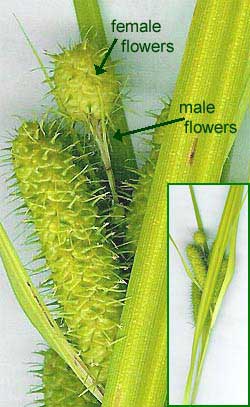Excerpts from Jim Conrad's
Naturalist Newsletter
from the July 13, 2006 Newsletter issued from Issued from Polly's Bend, Garrard County, in Kentucky's Bluegrass Region, USA
CAREX FRANKII
Among these hundreds of hilly acres of grassy pastures and weedy hayfields there's one tiny spot where species diversity soars, where I can always find something unusual and fascinating: down at the spring at the quadrangular, cinderblock water-tank surrounded by powerfully aromatic, yard-high spearmint, flitted over by blue and green Eastern Pondhawk dragonflies, and choked with floating mats of alga and duckweed.
 As you approach, one plant species immediately catches the eye, growing in mud right beside the tank. It's a waist-high, bushel-basket-size, dense tuft of leaves looking very much like stiff, overgrown, yellow-green grassblades. However, when you see the strange flowers you know that they are not grass flowers at al. You can see flowers from our very plant at the right.
As you approach, one plant species immediately catches the eye, growing in mud right beside the tank. It's a waist-high, bushel-basket-size, dense tuft of leaves looking very much like stiff, overgrown, yellow-green grassblades. However, when you see the strange flowers you know that they are not grass flowers at al. You can see flowers from our very plant at the right.
This is a sedge, CAREX FRANKII, of the Sedge Family, the Cyperaceae. The word sedge is a generic one, literally, meaning a member of the genus Carex. Moreover, knowing that a plant is a sedge is only the beginning: My old Gray's Manual of Botany describes 267 species of Carex just for northeastern North America.
Sedges are worth looking at, too. Because many are restricted to specific habitats -- Carex frankii likes swampy bottoms -- they are often good habitat markers. When I did "The Flora of McLean County, Kentucky" for my Master's thesis, I identified 22 species just in my dinky little home county.
If you enjoy contemplating "variations on a theme," sedges are perfect, for they provide every permutation of basic sedge-flower anatomy imaginable. For example, Carex frankii's male flowers, labeled in the picture at the link given above, are located beneath the female flowers on the terminal spike. In other species they're above the female flowers on the terminal spike. In yet others they are on each spike and in others there's just one spike to begin with. In others the males are scattered among the females, whether on one spike or several. On and on the variations of everything go, like an endless Bach fugue...
What a pleasure meeting this handsome Carex frankii next to the spring tank, amidst all that sunlight, the blue dragonflies, and aromatic spearmint!